Atmosphere
The atmosphere is a gaseous envelope surrounding and protecting our planet from the intense radiation of the Sun and serves as a key interface between the terrestrial and ocean cycles.
Although it only extends a few hundred kilometers above the surface, it contains a mixture of gases, such as oxygen and nitrogen, that are critical for life to exist. It distributes incoming solar radiation, protecting life from harmful ultraviolet radiation but also driving atmospheric circulation and weather. The atmosphere enables the greenhouse effect, which makes Earth more habitable. Human activity, however, is contributing more gases, many of which are negatively impacting the protective nature of this vital layer. NASA data provide measurements on weather phenomena as well as gases within the troposphere (the lowest layer of the atmosphere) and stratosphere (the layer above the troposphere) and their effect on air quality.

Aurora
Glowing auroras are the result of millions of individual particle collisions, lighting up Earth's magnetic field lines.
Auroras are a brilliant display of light in the night sky. The aurora borealis and aurora australis—also known as the northern and southern lights—occur mainly near Earth's poles. When the solar wind reaches Earth's magnetosphere, it can send charged particles trapped in Earth’s magnetic field raining down toward Earth's poles, driven by a powerful process called magnetic reconnection. Along the way, particles can collide with atoms and molecules in Earth's upper atmosphere, which provides the atoms with extra energy that they release as a burst of light. These interactions continue at lower and lower altitudes until all the excess energy is lost. Studying auroras offers insights on how our magnetosphere reacts to near-Earth space weather.

Biosphere
The biosphere encompasses all life on Earth and extends from root systems to mountaintops and all depths of the ocean.
The biosphere is made up of the parts of Earth where life exists. It extends from the deep ocean floor, to lush rainforests, and high mountaintops. This important sphere supports almost every aspect of human well-being and distinguishes Earth from other planets in our solar system. NASA data have changed the way we study life on Earth. Data on vegetation health, primary productivity, evapotranspiration, forest structure, and ocean chlorophyll provide insight into the health and productivity of the biosphere. The Sun is the only star we know of that supports a planet with a biosphere.

Climate Change
Human activities are driving the global warming trend observed since the mid-20th century.
Scientists attribute the global warming trend observed since the mid-20th century to the human expansion of the "greenhouse effect" — warming that results when the atmosphere traps heat radiating from Earth toward space. Over the last century, burning of fossil fuels like coal and oil has increased the concentration of atmospheric carbon dioxide (CO2). This increase happens because the coal or oil burning process combines carbon with oxygen in the air to make CO2.
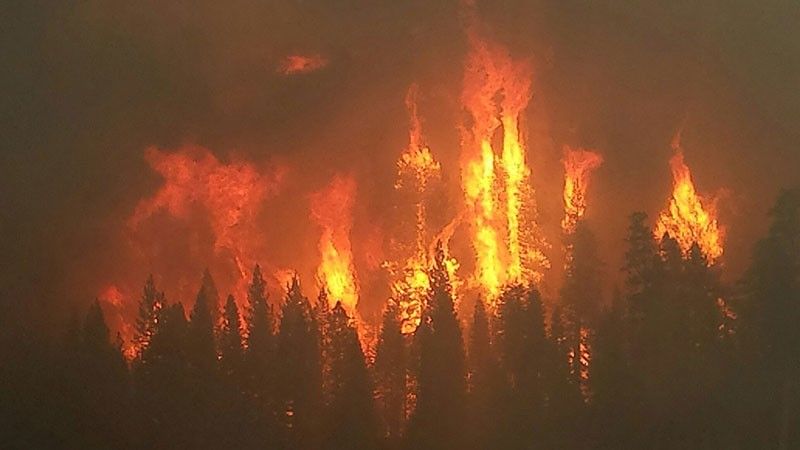
Convection
The rising of warm air and the sinking of cool air.
Heat mixes and moves air. When a layer of air receives enough heat from the Earth's surface, it expands and moves upward. Colder, heavier air flows under it which is then warmed, expands, and rises. The warm rising air cools as it reaches higher, cooler regions of the atmosphere and begins to sink. Convection causes local breezes, winds, and thunderstorms. Convection also occurs in the Sun, where convection currents help move energy from the core of the Sun to its surface.

Corona
The Sun's dynamic upper atmosphere is called the corona.
The corona is filled with plasma, whose movements are governed by the tangle of magnetic fields surrounding the Sun. Temperatures in the corona can reach up to millions of degrees. The corona is the source of the solar wind as well as solar flares and coronal mass ejections – the energetic solar eruptions that create the strongest space weather.

Coronal Mass Ejection
Coronal mass ejections, or CMEs, are large clouds of solar plasma and embedded magnetic fields released into space after a solar eruption.
CMEs expand as they sweep through space, often measuring millions of miles across, and can collide with planetary magnetic fields. When directed at Earth, a CME can produce geomagnetic disturbances that ignite bright aurora, short-circuit satellites and power grids on Earth, or at their worst, even endanger astronauts in orbit.

Electromagnetic Spectrum
Electromagnetic energy travels in waves and spans a broad spectrum from very long radio waves to very short gamma rays.
The human eye can only detect only a small portion of this spectrum called visible light. A radio detects a different portion of the spectrum, and an x-ray machine uses yet another portion. NASA's scientific instruments use the full range of the electromagnetic spectrum to study the Earth, the solar system, and the universe beyond. When you tune your radio, watch TV, send a text message, or pop popcorn in a microwave oven, you are using electromagnetic energy. You depend on this energy every hour of every day. Without it, the world you know could not exist.
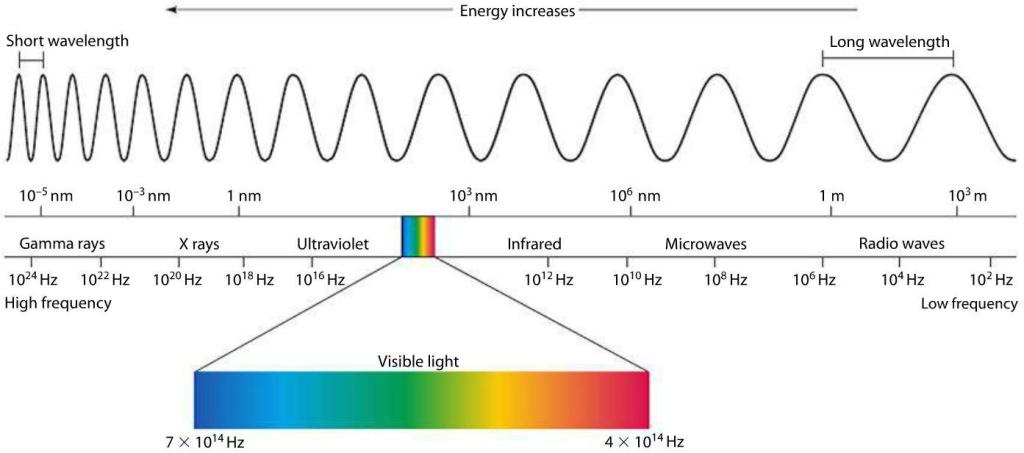
Electromagnetism
Electromagnetism is one of the fundamental forces of nature. Electric currents give rise to magnetism and conversely magnetism can induce electric currents.
The Sun is a giant magnetic star, made of material that moves in concert with the laws of electromagnetism. The Sun is made of a super-hot, electrically charged gas called plasma. The plasma rotates creating complex magnetic fields. The Sun’s magnetic field is responsible for everything from the solar explosions that cause space weather on Earth – such as auroras – to the interplanetary magnetic field and radiation through which our spacecraft journeying around the solar system must travel.

Energy
Our planet is constantly trying to balance the flow of energy in and out of Earth’s system, referred to as Earth's energy budget.
Radiative energy enters Earth’s system from the sunlight that shines on our planet. Some of this energy reflects off of Earth’s surface or atmosphere back into space. The rest gets absorbed, heats the planet, and is then emitted as thermal radiative energy the same way that black asphalt gets hot and radiates heat on a sunny day. Eventually this energy also heads toward space, but some of it gets re-absorbed by clouds and greenhouse gases in the atmosphere. The absorbed energy may also be emitted back toward Earth, where it will warm the surface even more. NASA data has confirmed that human activities are changing Earth's energy budget, trapping much more energy from the Sun than is escaping back into space.

Geomagnetic Storm
A geomagnetic storm is a major disturbance of Earth's magnetosphere that occurs when there is a very efficient exchange of energy from the solar wind into the space environment surrounding Earth.
Geomagnetic storms result from variations in the solar wind that produces major changes in the currents, plasmas, and fields in Earth’s magnetosphere. The solar wind conditions that are effective for creating geomagnetic storms are sustained (for several to many hours) periods of high-speed solar wind, and most importantly, a southward directed solar wind magnetic field (opposite the direction of Earth’s field) at the dayside of the magnetosphere. This condition is effective for transferring energy from the solar wind into Earth’s magnetosphere.

Greenhouse Effect
The greenhouse effect is the process through which heat is trapped near Earth's surface by substances known as 'greenhouse gases.'
Greenhouse gases are part of Earth's atmosphere and consist of carbon dioxide, methane, ozone, nitrous oxide, chlorofluorocarbons, and water vapor. Part of what makes Earth so amenable is its natural greenhouse effect, which maintains an average temperature of 15 °C (59 °F) . However, in the last century, human activities, primarily from burning fossil fuels that have led to the release of carbon dioxide and other greenhouse gases into the atmosphere, have disrupted Earth's energy balance. This has led to an increase in carbon dioxide in the atmosphere and ocean. The level of carbon dioxide in Earth’s atmosphere has been rising consistently for decades and traps extra heat near Earth's surface, causing temperatures to rise

Habitable Zone
The definition of “habitable zone” is the distance from a star at which liquid water could exist on orbiting planets’ surfaces.
Habitable zones are also known as Goldilocks’ zones, where conditions might be just right – neither too hot nor too cold – for life. While Venus, Earth, and Mars exist within the habitable zone around the Sun, only the conditions and ingredients on Earth allowed for life to evolve and flourish, most importantly the presence of water.
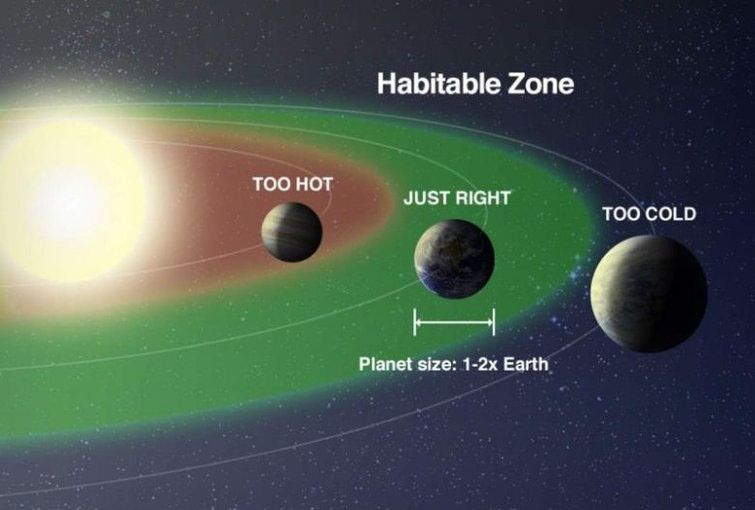
Heliosphere
The Sun’s constantly outflowing material, the solar wind, inflates a bubble in space called the heliosphere.
The heliosphere encloses all of the planets and is filled by the Sun’s plasma and magnetic field. In interstellar space outside the heliosphere, the interstellar medium and the galactic magnetic field are dominant. The heliosphere acts as a shield for our solar system, blocking many of the high-energy galactic cosmic rays from elsewhere in our galaxy. Of the spacecraft sent from Earth, only the twin Voyager spacecraft — traveling since 1977 — have been confirmed to have made it beyond the boundaries of the heliosphere.

Interstellar Space
Interstellar space is often called the space between the stars, but more specifically, it’s the region between our Sun’s heliosphere and the astrospheres of other stars.
Our heliosphere is a vast bubble of plasma – a gas of charged particles – that spews out of the Sun. This outflow is known as the solar wind. The bubble surrounds the Sun and stretches beyond the planets. Both Voyager spacecraft had to travel more than 11 billion miles (17 billion kilometers) from the Sun in order to cross the edge of the heliosphere. This bubble is moving through interstellar space as the Sun orbits the center of the Milky Way galaxy. As our heliosphere plows through space, it creates a bow wave, like the wave formed by the bow of a ship.

Ionization
A state of matter in which the electron is no longer bound to the nucleus of the atom.
The nucleus of an atom is surrounded by electrons that occupy shells, or orbitals of varying energy levels. The ground state of an electron, the energy level it normally occupies, is the state of lowest energy for that electron. There is also a maximum energy that each electron can have and still be part of its atom. Beyond that energy, the electron is no longer bound to the nucleus of the atom and it is considered to be ionized. We can observe ionization in our atmosphere during aurora events, when the solar wind excites the atoms in the atmosphere, causing them to collide and knock off electrons.

Light
All electromagnetic radiation is light, but we can only see a small portion of this radiation—the portion we call visible light.
Cone-shaped cells in our eyes act as receivers tuned to the wavelengths in this narrow band of the spectrum. Other portions of the spectrum have wavelengths too large or too small and energetic for the biological limitations of our perception. As the full spectrum of visible light travels through a prism, the wavelengths separate into the colors of the rainbow because each color is a different wavelength. Violet has the shortest wavelength, at around 380 nanometers, and red has the longest wavelength, at around 700 nanometers.

Lunar Eclipse
During a lunar eclipse, Earth comes between the Sun and the Moon, blocking the sunlight falling on the Moon.
When the Moon is entirely in the Earth's umbra (known as a total lunar eclipse or umbral eclipse), all sunlight reaching the lunar surface has been refracted or scattered through Earth's atmosphere. When the Moon is in Earth's penumbra (known as a penumbral eclipse), illumination comes from both direct sunlight and sunlight refracted and scattered through the planet's atmosphere. During some stages of a lunar eclipse, the Moon can appear reddish. This is because the only remaining sunlight reaching the Moon at that point is from around the edges of the Earth, as seen from the Moon's surface.

Lunar Phases
The only object in the solar system that shines with its own light is the Sun. That light always beams onto Earth and Moon from the direction of the Sun, illuminating half of our planet in its orbit and reflecting off the surface of the Moon to create moonlight.
Like Earth, the Moon has a day side and a night side, which change as the Moon rotates. The Sun always illuminates half of the Moon while the other half remains dark, but how much we are able to see of that illuminated half changes as the Moon travels through its orbit. When sunlight hits off the Moon's far side — the side we can't see without from Earth the aid of a spacecraft — it is called anew Moon. When sunlight reflects off the near side, we call it a full Moon. The rest of the month we see parts of the daytime side of the Moon, or phases. These eight phases are, in order, new Moon, waxing crescent, first quarter, waxing gibbous, full Moon, waning gibbous, third quarter and waning crescent. The cycle repeats once a month (every 29.5 days).

Magnetic Fields
The region around a magnetic material or a moving electric charge within which the force of magnetism acts.
Every magnet produces an invisible area of influence around itself. When things made of metal or other magnets come close to this region of space, they feel a pull or a push from the magnet. Scientists call these invisible influences fields. You can make magnetic fields visible to the eye by using iron chips sprinkled on a piece of paper with a magnet underneath. Did you know that the Earth, as well as some other planets, has a magnetic field? There are even magnetic fields on the Sun!

Magnetic Reconnection
When magnetic field lines become mixed, they can explosively snap and realign, flinging away nearby particles at high speeds in a process called magnetic reconnection.
This process occurs across the universe, including on the Sun, near black holes, and around Earth. Particles launched by magnetic reconnection near Earth can travel down along magnetic field lines into the atmosphere, where they can spark auroras.

Magnetosphere
A magnetosphere is the region around a planet dominated by the planet's magnetic field.
In our solar system, several planets, including Earth, and even one of Jupiter’s moons have magnetospheres. Magnetospheres of planets have a “teardrop” or ice cream cone shape, with a rounded, shorter end created as the Sun’s material pushes against the magnetic field and a long tail trailing away on the other side. Earth's magnetosphere has played a crucial role in our planet's habitability as it shields our home planet from solar and cosmic particle radiation, as well as erosion of the atmosphere by the solar wind.

Magnetotail
The side of the magnetosphere facing away from the sun - the nightside.
Like a windsock near a breezy airport runway, Earth’s magnetotail flaps back and forth in the gusty solar wind. The immense magnetotail of Earth fluctuates in length and can measure hundreds of Earth radii, far past the moon's orbit at 60 Earth radii.

Newton's Law of Gravity
All bodies attract each other with what is called gravitational attraction. This applies to the largest stars as well as the smallest particles of matter.
The force of attraction between two small bodies (or between two spherical bodies of any size) is proportional to the product of their masses and inversely proportional to the square of the distance between their centers. In other words, the closer two bodies are to each other, the greater their mutual attraction. As a result, to stay in orbit, a satellite needs more speed in a low than a high orbit.

Nuclear Fusion
Nuclear fusion is a process that produces energy when two nuclei join to form a heavier nucleus.
Nuclear fusion occurs in the core of the Sun and all stars. Immense pressures and temperatures in the star’s core squeeze the nuclei of hydrogen atoms together to form helium. Nuclear fusion releases energy, which heats the star and prevents it from further collapsing under the force of gravity. Astronomers call stars that are stably undergoing nuclear fusion of hydrogen into helium main sequence stars. This is the longest phase of a star’s life. The star’s luminosity, size, and temperature will slowly change over millions or billions of years during this phase. Our Sun is roughly midway through its main sequence stage. A high-mass star goes further. Fusion converts carbon into heavier elements like oxygen, neon, and magnesium, which will become future fuel for the core.

Photosynthesis
Photosynthesis is the process by which plants use sunlight, water, and carbon dioxide to create oxygen and energy in the form of sugar.
Plants grow and thrive through photosynthesis, a process that converts sunlight into energy. During photosynthesis, plants emit what is called fluorescence – light invisible to the naked eye but detectable by satellites orbiting hundreds of miles above Earth. NASA scientists have now established a method to turn this satellite data into global maps of the subtle phenomenon in more detail than ever before.
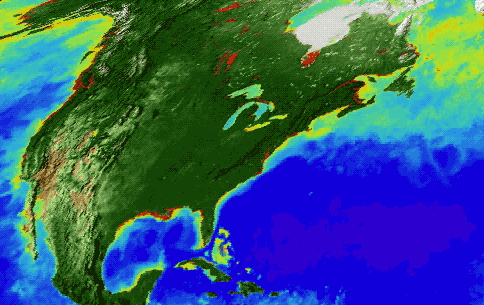
Plasma
Plasma is a gas consisting of electrically charged particles, a state of matter distinct from solids, liquids and gases .
Though rare on Earth, plasma makes up over 99% of the observable (i.e., not dark) matter in the universe, including every star, including our Sun, and much of the material between them. On Earth, plasma is found in fluorescent lights, torches used for metalworking, and lightning strikes. Plasma forms when the atoms in a gas become ionized, meaning electrons separate from the atom and move around independently. This makes plasmas electrically charged and they can interact with external electric and magnetic fields. They can also create their own electric and magnetic fields. Plasmas also undergo an explosive process called magnetic reconnection. Magnetic reconnection is a rapid transfer of magnetic energy into motion that powers solar flares and coronal mass ejections.

Radiation
Radiation is a form of energy that is emitted in the form of rays, electromagnetic waves, and/or particles.
Outside the protective cocoon of the Earth’s atmosphere is a universe full of radiation – it is all around us. Radiation can be created by humans (microwaves, cell phones, radios, light bulbs, diagnostic medical applications such as x-rays) or naturally occurring (the Sun, radioactive elements in the Earth’s crust, radiation trapped in the Earth’s magnetic field, stars, and other astrophysical objects like quasars or galactic centers). In some cases, radiation can be seen (visible light) or felt (infrared radiation), while other forms—like x-rays and gamma rays—are not visible and can only be observed with special equipment. Space radiation is different from the kinds of radiation we experience here on Earth. Space radiation is comprised of atoms in which electrons have been stripped away as the atom accelerated in interstellar space to speeds approaching the speed of light – eventually, only the nucleus of the atom remains.

Radio Blackout
Radio blackouts occur when the strong, sudden burst of x-rays from a solar flare hits Earth's atmosphere, jamming both high and low frequency radio signals.
The X-rays disturb a layer of Earth's atmosphere known as the ionosphere, through which radio waves travel. The constant changes in the ionosphere change the paths of the radio waves as they move, thus degrading the information they carry. This affects both high and low frequency radio waves alike. The loss of low frequency radio communication causes GPS measurements to be off by feet to miles, and can also affect the applications that govern satellite positioning.

Seasons
Changes in sunlight received by different parts of Earth resulting in temperature and weather fluctuations thought the year.
Earth's tilted axis causes the seasons. Throughout the year, different parts of Earth receive the Sun's most direct rays. So, when the North Pole tilts toward the Sun, it's summer in the Northern Hemisphere. And when the South Pole tilts toward the Sun, it's winter in the Northern Hemisphere. It is true that Earth's orbit is not a perfect circle. During part of the year, Earth is closer to the Sun than at other times. However, in the Northern Hemisphere, we are having winter when Earth is closest to the Sun and summer when it is farthest away! Compared with how far away the Sun is, this change in Earth's distance throughout the year does not make much difference to our weather. It is the tilt of Earth on its axis that causes the seasons, not the distance between Earth and the Sun.

Solar Cycle
The number of sunspots increases and decreases over time in a regular, approximately 11-year cycle, called the sunspot cycle.
The exact length of the cycle can vary. It has been as short as eight years and as long as fourteen, but the number of sunspots always increases over time, and then returns to low again. More sunspots mean increased solar activity, when great blooms of radiation known as solar flares or bursts of solar material known as coronal mass ejections (CMEs) shoot off the sun's surface. The highest number of sun spots in any given cycle is designated "solar maximum," while the lowest number is designated "solar minimum." Each cycle, varies dramatically in intensity, with some solar maxima being so low as to be almost indistinguishable from the preceding minimum.

Solar Eclipse
Eclipses happen when one object in space passes through the shadow of another object in space. During a solar eclipse, the Moon passes between the Sun and Earth, blocking all or part of the Sun for the viewer.
Depending on where Earth and the Moon are in their orbits, there are different types of solar elclipses. An annular eclipse happens when the Moon is lined up between the Sun and Earth, but at its farthest point from Earth. Because the Moon is farther away from Earth, it seems smaller. It does not block the entire view of the Sun. A total eclipse happens when the Moon is lined up between the Sun and Earth, but at its closest point from Earth. Because the Moon is closer to Earth, it seems bigger. It blocks the entire view of the Sun. People who see the total eclipse are in the center of the Moon’s shadow when it hits Earth. Those not in the center of the Moon's shadow will experience a partial eclipse, with only a part of the Sun appearing to be covered. A fourth type of eclipse, known as a hybrid eclipse, appears as an annular in some places and a total in others as the Moon’s shadow moves across Earth’s surface.
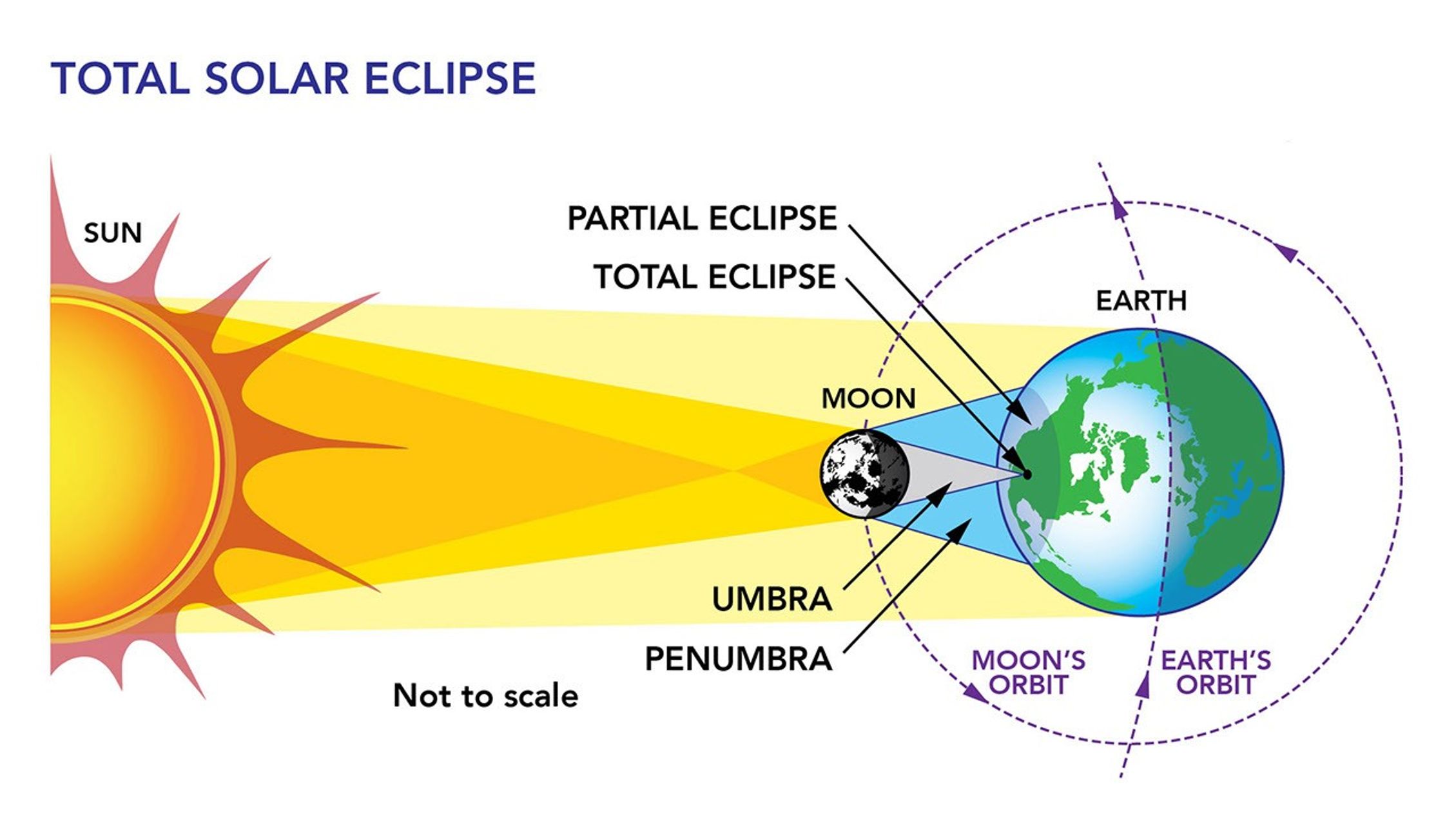
Solar Flare
Solar flares are energetic bursts of light and particles triggered by the release of magnetic energy on the Sun.
Solar flares are by far the most powerful explosions in the solar system, with energy releases comparable to billions of hydrogen bombs. The energetic particles accelerated by flares travel nearly at the speed of light, and can travel the 93 million miles between the Sun and Earth in less than 20 minutes. Some solar flares have an associated coronal mass ejection. The biggest flares are known as "X-class flares" based on a classification system that divides solar flares according to their strength. The smallest ones are A-class (near background levels), followed by B, C, M and X. Similar to the Richter scale for earthquakes, each letter represents a 10-fold increase in energy output. So an X is ten times an M and 100 times a C. C-class and smaller flares are too weak to noticeably affect Earth. M-class flares can cause brief radio blackouts at the poles and minor radiation storms that might endanger astronauts.

Solar System
The solar system has one star, eight planets, five officially named dwarf planets, hundreds of moons, thousands of comets, and more than a million asteroids.
There are many planetary systems like ours in the universe, with planets orbiting a host star. Our planetary system is called “the solar system” because we use the word “solar” to describe things related to our star, after the Latin word for Sun, "solis." Our solar system consists of our star, the Sun, and everything bound to it by gravity – the planets Mercury, Venus, Earth, Mars, Jupiter, Saturn, Uranus, and Neptune; dwarf planets such as Pluto; dozens of moons; and millions of asteroids, comets, and meteoroids.

Solar Wind
The solar wind is a gusty stream of material that flows from the Sun in all directions, all the time, carrying the Sun’s magnetic field out into space.
While it is much less dense than wind on Earth, it is much faster, typically blowing at speeds of one to two million miles per hour. The solar wind is made of charged particles — electrons and ionized atoms — that interact with each other and the Sun’s magnetic field. The extent of the solar wind creates the heliosphere, the Sun’s region of influence within interstellar space.

Space Weather
Space weather refers to conditions in space produced by the Sun’s activity.
The Sun affects the space around us through a constant stream of plasma known as the solar wind, with occasional bursts from solar flares and coronal mass ejections. These solar discharges carry their own magnetic field, so when they collide with Earth’s magnetic field, the two magnetic fields can repel or attract each other like two magnets. This repulsion and attraction creates geomagnetic disturbances. Space weather events produce the beautiful glow of the northern and southern lights, but they can also endanger astronauts, disrupt radio communications, and even cause large electrical blackouts. Every planet in the solar system experiences its own space weather as the solar wind interacts with the planet’s own magnetic field (or lack thereof).

Spectroscopy
Spectroscopy is the science of reading light to determine the size, distance, spin and chemical composition of distant objects in space.
Spectroscopy is a complex art - but it can be very useful in helping scientists understand how an object like a black hole, neutron star, or active galaxy is producing light, how fast it is moving, and even what elements it is made of. A spectrum is simply a chart or a graph that shows the intensity of light being emitted over a range of energies. Spectra can be produced for any energy of light - from low-energy radio waves to very high-energy gamma-rays.

Stellar Evolution
Stellar evolution describes the life cycle of a star.
A star is born, lives, and dies, much like everything else in nature. Stars are giant balls of hot gas – mostly hydrogen, with some helium and small amounts of other elements. Every star has its own life cycle, ranging from a few million to trillions of years, and its properties change as it ages. The fate and life of a star depends primarily on its mass. Astronomers estimate that the universe could contain up to one septillion stars – that’s a one followed by 24 zeros. Our Milky Way alone contains more than 100 billion, including our most well-studied star, the Sun.

Sun
The closest star to Earth (149,599,000 km away on average).
The Sun dwarfs the other bodies in the solar system, representing approximately 99.86 percent of all the mass in the solar system. One hundred and nine Earths would be required to fit across the Sun's disk, its interior could hold over 1.3 million Earths. The Sun appears to have been active for 4.6 billion years and has enough fuel for another 5 billion years or so. At the end of its life, the Sun will start to fuse helium into heavier elements and begin to swell up, ultimately growing so large that it will swallow Earth. After a billion years as a 'red giant,' it will suddenly collapse into a 'white dwarf.' It may take a trillion years to cool off completely.

Sunspots
Sunspots are cooler regions on the Sun’s visible surface caused by a concentration of magnetic field lines.
Sunspots are the visible component of active regions, areas of intense and complex magnetic fields on the Sun that are the source of solar eruptions. Lasting from days to months, sunspots typically stretch 1,000 to 100,000 miles across. The number of sunspots goes up and down as the Sun goes through its natural 11-year cycle. Scientists use sunspots to help them track this cycle.
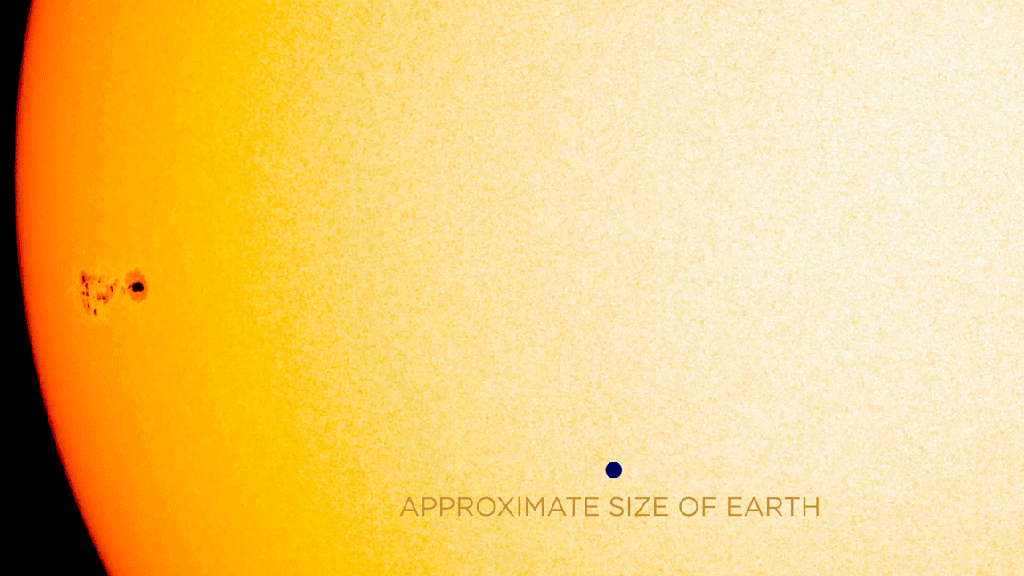
Transits
A transit happens when one celestial body crosses in front of another from a specific point of view.
Eclipses are a type of transit. On Earth, we most often see Mercury transit the Sun, or – even more rarely – Venus. Transits are also one of the primary ways scientists look for evidence of exoplanets, planets beyond our solar system. As exoplanets pass between their host star and Earth, the light we measure from the host star decreases slightly, giving scientists clues about the planet or planets that may be orbiting that star.

Van Allen Belts
Named for their discoverer, James Van Allen, these concentric, doughnut-shaped rings encircle Earth and are filled with high-energy particles trapped by Earth’s magnetic field to create the radiation belts.
The particles that make up the Van Allen Belts – electrons and ions – gyrate, bounce, and drift through the region, sometimes shooting down into Earth's atmosphere, sometimes escaping out into space. The radiation belts swell and shrink during 1-3 day long geomagnetic storms as part of a much larger space weather system driven by energy and material that erupts off the Sun and fills the entire solar system. The Van Allen Belts are an important component of the Earth’s magnetosphere.

Heliophysics Resource Database
Explore these topics with heliophysics resources at each level in the Heliophysics Resource Database.
Resource Database


























